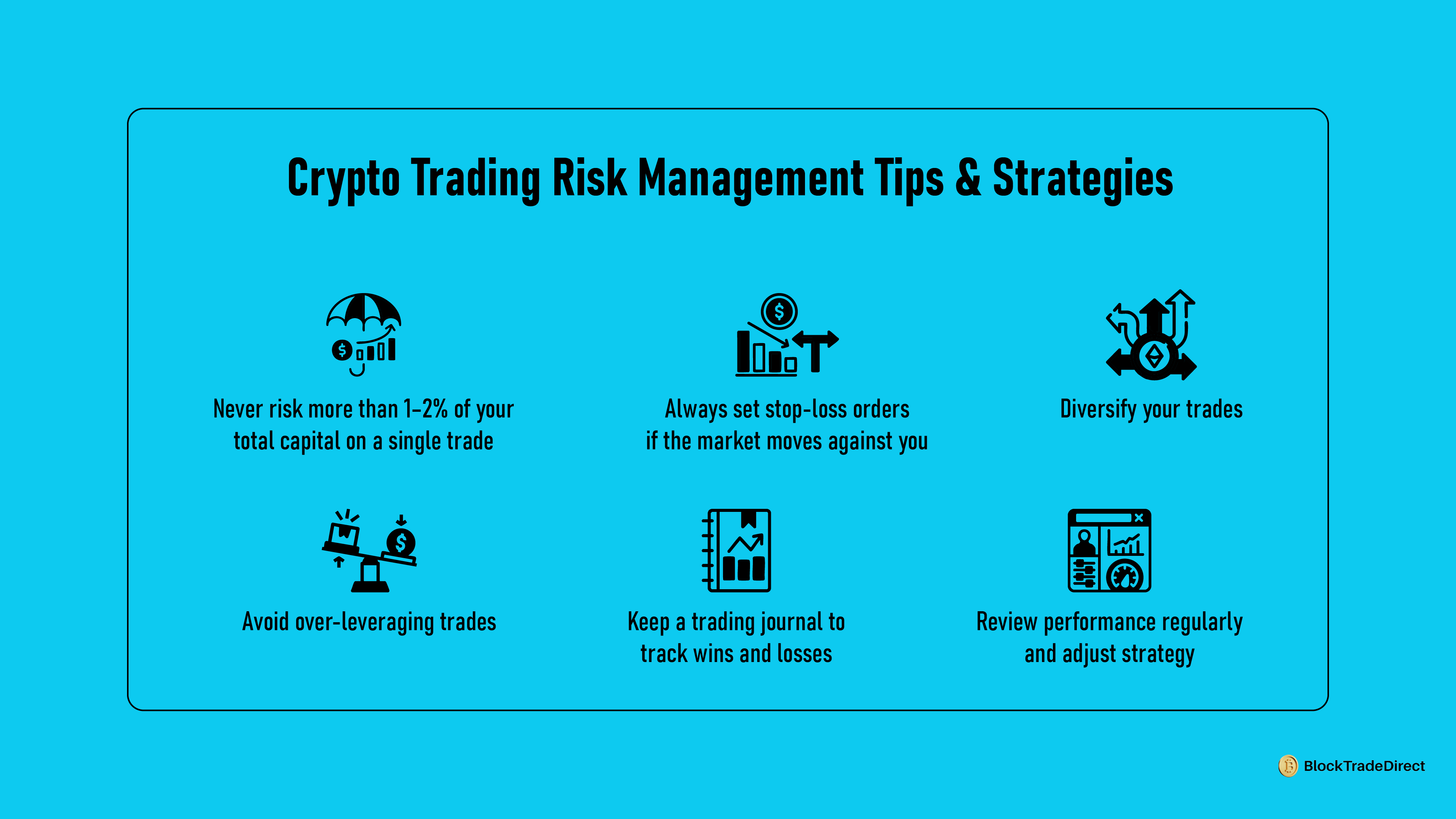
More than 70% of new crypto investors go in the red in the first six months, according to recent statistics supplied by Binance Research and CoinMarketCap. The reason most times isn't bad timing or manipulation of markets—it's just a plain human mistake. Emotional trading decisions, inadequate planning, and weak risk management are among the most frequent errors that whittle portfolios away faster than market swings ever could.
Crypto trading is volatile, emotional, and fast. The prices go up 20% in twenty-four hours and then plummet just as quickly. Without discipline, even smart traders find themselves in pitfalls like chasing trends, panic selling, or ignoring basic security procedures. The result is the loss spiral that can be avoided with the appropriate strategy and patience in short order.
It exposes the most frequent crypto trading blunders of 2025 and how to avoid them. No matter if you're new to the market or you've traded during several bull and bear markets, the idea remains the same—trade smarter, keep your money, and avoid making errors that the overwhelming majority of traders do not even realize that they're making.
Fear and greed are the biggest foes for crypto traders. Market volatility may tempt even the well-disciplined traders to buy during the rallies or sell off during the sudden dips. This emotional outburst—colloquially called FOMO (Fear of Missing Out) and panic unwinding—is one of the most common mistakes of new crypto traders.
When the Bitcoin or altcoins surge, hype spreads across social platforms with people rushing in without verifying the fundamentals or the timing. The opposite occurs during the plummeting prices. Traders close out due to panic, with the market bouncing back days afterward. Speculating out of emotion instead of analysis commonly leads to the repercussions of buying at the high and selling at the low.
How to prevent it:
Get trained in analyzing and reading cryptocurrency price charts so you can base decisions on facts rather than sentiments.
Traders worry about making money and do not pay attention to the number one trading rule—safeguard your capital at all costs. Bad risk management is among the major reasons why traders lose money. Without definite parameters of how much risk to assume on each trade, several losses can eliminate months of profits.

One of the most underappreciated blunders is overexposure—investing too much money in one trade or coin. When the tide turns, losses compound quickly. Take risking 10% of your portfolio on each trade: it can create a 50% drawdown in just five consecutive losing trades. That's why the pros operate under the 1–2% rule: no trade should risk more than 2% of your entire portfolio.
However, another element of successful risk management with crypto trading is stop-loss orders. These get you out of your position once the prices descend below some predetermined level without you having to do anything out of emotion. Diversification also comes into play—spreading assets in terms of industry, market cap, and volatility disperses the risk better.
Risk management mastery won't just preserve your funds—it will keep you in the game long enough to learn and improve.
Crypto's dynamic prices may lure traders in and out of the market excessively. The vice of overtrading tends to commence with the right motives—chasing every little movement or unwinding losses fast—but it ends in tiredness and additional errors.
During periods of market volatility, traders initiate numerous positions with weak settings, excessive leverage, or aiming at small moves. Each position contributes risk and fees that eat away at profits. The repeated action also creates decision fatigue that wears away attention and discipline over time.
Successful traders also recognize the fact that all price moves are trades. Waiting for solid setups and positive confirmation signals tends to generate higher returns than trading off noise.
Ways to avoid overtrading:
When volatility increases, patience is a tactic. Good setups inevitably beat incessant guessing.
One of the most damaging crypto investment mistakes is wading into a trade without an idea of what you're buying. Traders all too easily turn to advice on Twitter or publicity stunts by promoters in place of digging in themselves—something in the crypto community known by the term DYOR (Do Your Own Research).
Neglecting research can lead to investment in poor or fraudulent projects. Tokens with poor fundamentals, weak tradeability, or limited practical utility can all plummet overnight, with investors stranded in losses.
Before making any crypto purchase, go over the fundamentals:
Rapid research checklist:
It also takes just a couple of hours of research to avoid costly newcomer crypto mistakes in the future. Understanding how something works makes you invest with evidence rather than with trends.
Leverage can either amplify trivial price movements into massive wins—or gargantuan losses. Speculators consider it the freeway to bigger returns; trading with leverage without sufficient knowledge remains one of the most popular errors in crypto trading.
Leverage enables you to handle a larger position with little capital. Suppose with 10x leverage, you can buy $10,000 worth of crypto with a $1,000 margin. The potential loss is that with just a 10% plummet in the market, you lose your entire position and face liquidation. This may happen within minutes in highly volatile markets.
It also offers emotional intensity. Small moves appear enormous on a highly leveraged account, precipitating panic exits or revenge trading.
How to prevent leverage pitfalls:
Leverage is acceptable within the toolbox given that it's applied with discipline and intention. It's seldom worth it with new traders until risk management skills become solid.
Most people err in having the full portfolio invested in one coin or asset class. Although it will reward in the unlikely event it occurs, the potential for complete loss is large. This is among the most common crypto errors and the top reason for preventable losses.
Diversification distributes risk over several assets, market caps, and industries. Mixing stablecoins with large-cap coins such as Bitcoin and Ethereum with smaller altcoins may minimize the risk of a sharp market decline.
Ways to minimize risk by diversifying:
Diversification also doesn’t eradicate risk but insulates against catastrophic losses and helps traders survive fluctuating market periods with less tension.
Even the smartest trading plans go wrong if the crypto assets do not exist in the safest places. Most traders commit typical mistakes with crypto wallets, like keeping the private keys on the Internet, broadcasting seed phrases, or forgetting the security options like two-factor authentication (2FA). These blunders expose funds to hacks, phishing scams, and robberies.

Brief security checklist:
Learn how to protect your crypto investment and prevent it from being stolen. Good trading discipline prevents losses that cannot be made back by trading skill.
8. Selecting the Incorrect Crypto Exchange
Choosing the appropriate exchange is vital. Most traders do not consider aspects such as security, fees, and liquidity, which may incur avoidable losses or forgone gains. Failing to research an exchange properly is among the most frequent crypto trading errors.
Trades become either centralized (CEX) or decentralized (DEX). That's just the brief comparison:
|
Feature |
Centralized Exchange |
Decentralized Exchange |
|
Custody |
Hold your funds |
You control your funds |
|
Fees |
Usually higher |
Often lower, but variable |
|
Security |
High, but hack risk exists |
Depends on smart safety |
|
Liquidity |
High, easy trades |
Can be lower, slippage possible |
Centralized exchanges are liquid and most convenient, but require trust. Decentralized exchanges give maximum control but may be less user-friendly and riskier in the event of faulty contracts.
Get to know the advantages and disadvantages of centralized and decentralized exchanges prior to trading. The correct choice can avoid mishaps and ensure the security of your capital and potential trade.
It tests the discipline of every trader. Most commit the crypto bear market blunder of panic selling, giving up on long-term plans, or shunning research completely. They can seal losses and recover even less during the turnaround in the market.
Traders who do well pay attention to keeping perspective and following established procedures. Strategies such as Dollar-Cost Averaging (DCA), portfolio rebalancing, and keeping updated on trend knowledge allow losses to be diminished. A bear market is more than just a phase of decline; it's also a time to fortify risk management and improve trade procedures.
How to avoid bear market mistakes:
It's all about making adjustments and patience. Well-disciplined traders who incur losses position themselves for larger gains once the market recovers.
Most traders enter positions without prior consideration of how and when to exit. This leads to holding on too long because of greed, selling too early because of fear, or missing the whole profit potential. Not planning precisely how you will exit the trade is one of the most common mistakes among crypto traders.
It's as simple as having an exit strategy:
Systematically following the rules of exits helps solidify the profits, limit the risk, and prevent trading on emotion.
Sophisticated crypto traders do not just rely on luck—they also trade by the rules that avoid loss and preserve capital. By learning their approach, newbies and intermediate traders can learn how to avoid mistakes.
Vital attributes of successful traders:
Practice crypto trading in a demo account before going live and perfect your skills risk-free. Consistent adherence to such habits makes the traders disciplined, informative in their decisions, and avoids pitfalls that ensnare inexperienced participants.
It's less about being lucky and more about being prepared. From emotional trading and overleveraging to inadequate research and poor security measures, any mistake can be avoided with discipline, planning, and unlimited education.
Key takeaways:
By focusing on these principles, traders can protect capital, reduce stress, and increase the odds of long-term success. Consistency, education, and thoughtful risk management turn mistakes into learning opportunities, creating a solid foundation for smarter crypto trading.
Common mistakes include emotional trading, ignoring risk management, overtrading, poor research, overleveraging, lack of diversification, weak wallet security, choosing the wrong exchange, and failing to adapt during bear markets
Set a predefined trading plan, use stop-losses, take breaks during volatility, automate trades, and make decisions based on data, not social media hype.
Follow the 1–2% rule, use stop-loss and take-profit orders, diversify your portfolio, and maintain a trading journal to track and review trades.
Use hardware wallets, enable 2FA, never share seed phrases, verify URLs, and keep wallet software up to date.
Panic selling, abandoning strategies, ignoring research, and overreacting to short-term price movements are common errors during bear markets.
High leverage increases risk significantly. Beginners should avoid leverage or start with very low levels until they fully understand its effects.
Use demo accounts to test strategies without risking real money, track performance, and refine techniques before going live.
Centralized exchanges offer higher liquidity and ease of use but require trust. Decentralized exchanges give full control over funds but may have lower liquidity and smart contract risks. Choose based on your priorities and experience level.